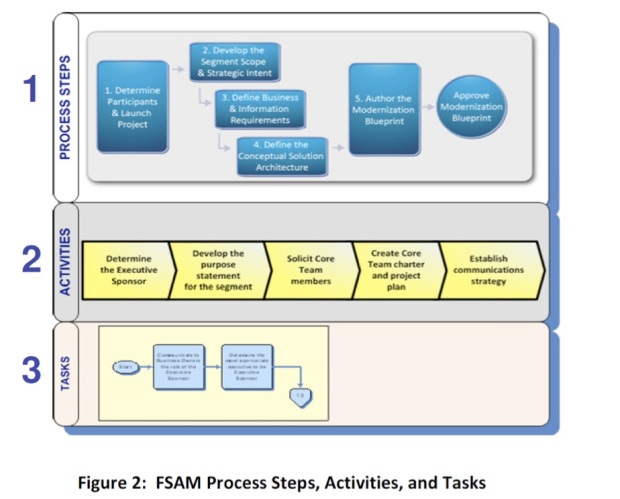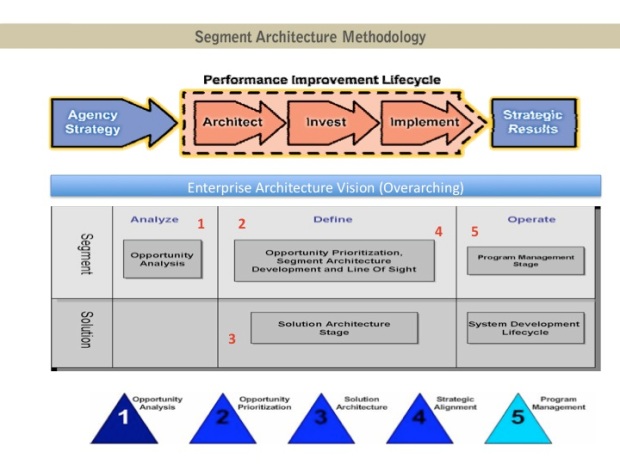The new Federal Segment Architecture Methodology Link below.
Reference: FEA Practice Guidance (This is the old link prior to 2009)
By Srinidhi Boray
Following inaccuracies in the OMB’s Reference Model and Segment Architecture Methodology – allows for inadvertently promoting bureaucracy in the agency’s OCIO rather than reducing it.
1. Notion of ‘Reuse’ by extending the abstraction of ‘common services’
To understand “reuse plan” with regards to agencies redundancy reduction planning it is worth establishing clarity between “empirical” and “analysis,” with regards to “common services” a term defined within the Federal Enterprise Architecture Reference Model framework that was established by the Office of Management and Budget (OMB). The Federal Enterprise Architecture (FEA) is a business- and performance-based framework designed to facilitate cross-agency collaboration, transformation, and government-wide improvement.
oEmpirical –
§ Relying on experience or observation alone often without due regard for system and theory (ref – http://www.merriam-webster.com/dictionary/empirical)
oAnalysis –
§ 1: separation of a whole into its component parts
§ 2 a: the identification or separation of ingredients of a substance b: a statement of the constituents of a mixture
§ 3 a: proof of a mathematical proposition by assuming the result and deducing a valid statement by a series of reversible steps b (1): a branch of mathematics concerned mainly with limits, continuity, and infinite series (2): calculus 1b
§ 4 a: an examination of a complex, its elements, and their relations b: a statement of such an analysis
(ref –http://www.merriam-webster.com/dictionary/analysis)
The term “common services” defined within the Service Reference Model has an empirical notion. Meaning it is something that observed or experienced. It does not lend to analysis that is necessary to understand the system behavior, wherein the system is composed of components having ‘logical’ behavior that can be created in a componentized manner. With this as the basis it must be concluded that during the application of the notion ‘common services’ in the reuse plan, it is merely applied in the empirical sense, although the intension is to eventually drive the results derived into analytical perspectives that is useful for designing technical reusable components across agency line of businesses.
2. Service Reference Models as Service Oriented Architecture
Although the Service Reference Model is useful for conducting planning to achieve reuse across (intra) agencies by means of exploring common services, it does not lend satisfactorily into logical architecture analysis for an (inter) agency. Especially that analyzes the “business–to–system” and “system-to-system” interactions that uniquely fulfill a business sub-function. It must be noted that when the enterprise architecture migrates towards Services Oriented Architecture supported by infrastructure built upon the Enterprise Service Bus, the “system-to-system” analysis will be no more relevant as the interactions will be designed into a logical federated architecture. The notion of ‘business services’, ‘enterprise services’ etc within the Service Reference Models are empirical and not analytical useful for any architecturally significant discussion. Especially with regards to Service Oriented Architecture (SOA). Although, SRM could be used as ‘conceptual’ models they do not satisfactorily extend into logical ‘SOA’ based constructs.
The reuse analysis based on ‘common services’ does not target any implementation strategy via a design decision particularly that is uniquely based on the ‘service oriented architecture’. It merely looks for occurrence of ‘common services’ and establishes a case for driving a composite set of software tool that will eventually help in establishing unified EA framework
3. Planning Segment Architecture in isolation inherently promotes ‘Silos’
OMB guidance introduces distortions in the big picture considerations deemed necessary for redundancy reduction planning in the segment architecture area. During redundancy reduction planning, if the segment architectures are individually attempted as per the agency business priorities, then there is always a lurking danger of planning the operational and tactical aspects at the segment architecture level that does not include the issues that impacts the overall agency. As enterprise architecture in its overarching sense is in the missing, although it is spoken in terms of reference models.
Power of Architecture as a Discipline:
Techniques within architecture can endow mind with great capacity. For instance “perspective” is one such great capability with which one can create accurate representations even being blind-folded. This is the power of the architecture as a discipline. Perspective was such a reckoning force that it triggered “Renaissance”.
Read about Esref Armagan, who despite being blind has mastered art by developing ability for perspectives.
http://www.esrefarmagan.com/index-en.html
Watch the video on Esref Armagan
Note: When the planning mechanism inherently relies on the ’empirical’ notions rather than rationality arrived from incisive analysis and design decisions, then ’empirical dilemma’ occurs. This also leads to cognitive dissonance. The ontology used to describe the architecture of the system riddled with ’empirical dilemma’ will be lacking in logical arrangement of their structure both in spatial and temporal sense. Furthermore, this contributes to the inaccuracies in the behavioral description of the system. When one speaks of a behavior, it must be presumed that something is being measured which makes it observable and hence it has a performance. When any behavior is observed, then what meets the eye and what meets the mind are two different perceptions. The intrinsic logic that contributes to the system behavior must always be sought rather than relying on the outer manifestations. It is the outer manifestation which typically is ’empirical’. Owing to issues like these, the Reference Models do not sufficiently lend themselves as Architectures.

